
 stained glass
- The art of cutting colored glass
into different shapes and
fitting them into channeled lead
strips, which are also called came.
These are then soldered
together, and usually installed in an iron framework to create a window.
stained glass
- The art of cutting colored glass
into different shapes and
fitting them into channeled lead
strips, which are also called came.
These are then soldered
together, and usually installed in an iron framework to create a window.
Begun in Eastern Asia and among Muslim designers, the art of stained glass reached its height in the Middle Ages, particularly 1150-1250. As the solid Romanesque wall was eliminated, the use of glass could be and was expanded. Integrated with the lofty verticals of Gothic cathedrals, large windows afforded greater illumination that was regarded as symbolic of divine grace. These glaziers followed a cartoon to cut the glass, and fired the painted pieces in a kiln. Oxides fused with the molten glass to produce the intense colors of small pieces whose irregular surfaces created sparkling refractions of light. Outstanding examples of twelfth century stained glass can be found in the windows of such churches as Saint-Denis, in Paris, and Canterbury, in England. Among the finest thirteenth century works are the windows at Chartres and the Sainte-Chapelle in Paris. (See rose window.)
With improved glassmaking many medieval qualities vanished, and by the sixteenth century a lesser art was produced with larger, smoother pieces and sophisticated painting techniques.
In the nineteenth century, Romanticism and the Gothic revival caused renewed interest in stained glass. Important contributions to the art were made by William Morris (English, 1834-1898), John La Farge (American, 1835-1910) and Louis Comfort Tiffany (American, 1848-1933). Historians of this period have long argued about whether La Farge or Tiffany invented the copper-foil alternative to lead came, but Tiffany is universally credited with developing an opalescent colored glass and with making extensive use of copper-foil in windows, lamps, and other decorations.
In modern art the medium has been used by Georges Rouault (French, 1871-1958), Henri Matisse (French, 1869-1954), and Marc Chagall (Russian-French, 1887-1985).
Examples:
![]()

![]()
French, Windows of La Sante Chapelle, Paris, 1243-48.


France,
Rose
Window of the Cathedral of Notre Dame of Paris, interior view.
An exterior view showing the finely carved
and assembled stone tracery supporting this rose window.
Construction of this cathedral began in
1163 and was completed 1345.
See architecture.

Southern Germany, Stained Glass of St. George, 1400-1410,
colored glass, lead, 59
x 39 cm, Hermitage Museum, St. Petersburg, Russia.
Karl von Egeri (?) (Switzerland, Zurich), Panel with Arms and View of the Town of Konstanz, 1538-1540, colored and painted glass, lead, 48.2 x 44 cm, Hermitage Museum, St. Petersburg, Russia.

Karl von Egeri (?) (Switzerland, Zurich),
Stained Glass of the Standard Bearer of the Landsknecht,
1551, colored and painted glass, lead,
49.5 x 38.5 cm, Hermitage Museum, St. Petersburg, Russia.
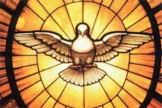
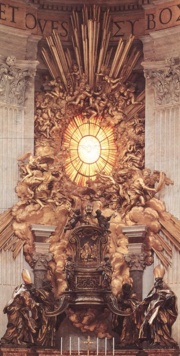
Gianlorenzo Bernini (Italian, 1598-1680),
Dove
of the Holy Spirit, c. 1660.
This stained glass window is the highly
dramatic focal point of
The
Throne of Saint Peter, 1657-66, marble, white and gilt stucco,
and stained glass, overall height
about 100 feet, Saint Peter's Basilica, Vatican, Rome.
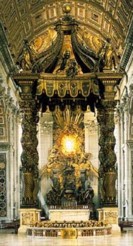
The Throne is a huge Baroque sculptural composition behind the altar, in the apse of the basilica.
When walking toward the Throne of Saint
Peter from the main entrance of the church, a viewer
first sees its important
stained glass window as it is framed
by Bernini's Baldacchino, 1624-33.
See baldacchino.
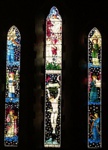

Sir
Edward Coley Burne-Jones (English, 1833-1898), designer; William
Morris, fabricator, East Windows, details of the center window:
Crucufixion: lower and upper, Ascension:
lower and upper, colored and painted glass, lead,
St. James Church, Stavely, Cumbria, England. Photos © Neil Ralley, with permission.
See Pre-Raphaelite
Brotherhood.

William Morris (English, 1834-1896), Guinevere and Iseult: Cartoon for Stained Glass,
1862, chalk, pencil and watercolor on paper,
61.0 x 685 cm, Tate Gallery, London. See Arts
and Crafts Movement and cartoon.

William Morris, Angel of the Resurrection: Cartoon for Stained
Glass, 1862, crayon,
pencil and watercolor on paper,
68.9 x 46.5 cm, Tate Gallery, London.
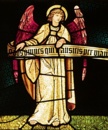
William Morris, designer and fabricator,
One
of Six Angels Holding a Scroll, colored and painted glass,
lead, Trinity Church, Saugerties,
NY. Photo
© Neil Ralley.
![]()
John La Farge (American, 1835-1910), Peacock
Window, 1892-1908, colored and painted glass, lead,
Worcester Art Museum, MA.
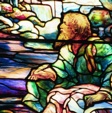
Louis Comfort Tiffany (American, 1848-1933),
designer; Tiffany Studios, fabricator, St.
John's Vision on Patmos, colored and painted glass, lead, Union Congregational
Church, Montclair, NJ. Photo © Neil Ralley.

Tiffany Studios, the Rose Window of First Unitarian Church of
Cincinnati, 1900, located in the front of the church's sanctuary.
Along the periphery at the seven virtues of Truth, Love, Patience,
Freedom, Righteousness, Courage, and Justice. See a photo of this window in situ.

American (Tiffany Studios?), Window in the Winchester
"Mystery House," c. 1890s (house built 1884-1922), colored and beveled glass, San Jose,
CA. Sarah L. Winchester, a wealthy widow -- heiress to the Winchester
Rifle fortune -- began the construction of what became a 160-room
mansion, ending only at her death 38 years later. This may
be one of the windows she commissioned
Tiffany Studios to produce for the house. See Art Nouveau.

Frank Lloyd Wright (American, 1867-1959),
Clerestory Window from Avery Coonley
Playhouse, Riverside, Illinois, 1912, colored and clear leaded
glass, 18 5/16 x 34 3/16 inches (46.5 x 86.8 cm). See grid.
Henri Matisse (French, 1869-1954), Pale-Blue Stained-Glass Window, 1949, two panels: gouache on paper, glued onto paper, mounted on canvas [a design for a window], 509.8 x 252.3 cm, Centre Georges Pompidou, Paris. See cutout.

Henri Matisse, one of two windows in the
Chapelle du Rosaire, St.
Paul de Vence, France, 1951.

Evie Hone (English, 1894-1955), The Crucifixion, 1948, leaded glass,
39.4 x 50.8 cm, Tate Gallery, London.
Also see fenestration, kaleidoscope, rondel, rosette, and tracery.
https://inform.quest/_art